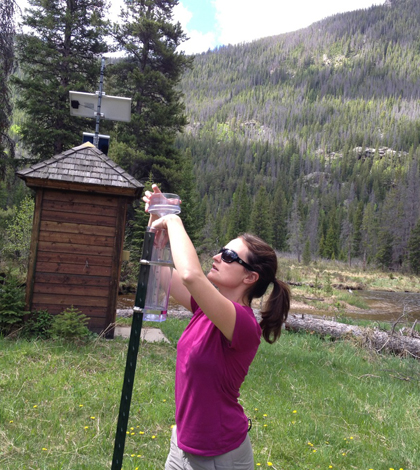Mountain pine beetle outbreak leaves more groundwater for streams

Rainfall samples collected in watershed with trees killed by mountain pine beetles helped parse out streamflow sources (Credit: Lindsay Bearup)
The largest-ever outbreak of destructive mountain pine beetles across western North America isn’t just turning mountainsides from green to red to grey as millions of lodgepole pines die off. The effects are cascading through the water cycle, as trees that once took up and transpired shallow groundwater now leave it below the surface where it eventually flows into mountain headwater streams.
The new findings on mountain pine beetle effects on hydrology in mountain forests come from a study of two watersheds in Rocky Mountain National Park, where beetles have killed millions of trees since 1996.
The beetles’ recent success appears to be related to climate change. Cold temperatures once served as an important control on their populations, but the low of 30 degrees Fahrenheit generally understood to kill the beetles has become more rare, according to Reed Maxwell, professor in the Colorado School of Mines’ Department of Geology and Geological Engineering.
“In a lot places in the Rocky Mountains, if you look at any weather station you’ll see that the number of years with that cold of a temperature are fewer and fewer,” said Reed, co-author of the watershed study. “In fact, a lot of the stations in the areas we work in — Grand Lake on the west side of Rocky Mountain National Park — they don’t have a minus-30 reading between, say, ’92 and last year.”
Combined with a persistent low-level drought that may be reducing the trees’ ability to produce enough sap to eject burrowing beetles, Reed said the net result is a “perfect storm” in affected areas where “basically all the mature lodgepole pines are dead.”
And dead trees don’t use water. The study from Maxwell and lead author Lindsay Bearup, a doctoral student in the Colorado School of Mines’ Hydrological Science and Engineering Program, found that shallow groundwater that would have otherwise been taken up by trees in late summer is left behind and ultimately contributes to streamflows in beetle-infested waterheds.

Mountain pine beetle destruction seen near Bear Lake in Rocky Mountain National Park (Credit: Lindsay Bearup)
The fraction of streamflows made up of groundwater was 30 percent greater in a watershed with a more recent and intense infestation than a similar nearby watershed with an older and milder infestation.
“This would suggest that there’s more water available in streams. This would also suggest that there’s going to be more water available in storage,” Reed said. “But I wouldn’t say that it’s going to be a boon for water availability because it’s a pretty complicated system and this is just one piece of it.”
The system’s complexity has made it difficult to assess the hydrologic impacts of beetle infection, he said. Studies using sap flow meters have helped resolve effects on single trees, but scaling that up to the watershed level is more complicated. This study is the first attempt to do so, according to Reed.
The researchers identified the share of streamflows made up of groundwater by first sampling rain gauges, snow pits and shallow groundwater wells across both watersheds in the summer of 2012. By using stable isotope analysis and conductivity measurements to identify each source by a chemical fingerprint, they could apportion out the contribution of each source in samples taken from the streams flowing through each watershed.
In addition to comparing two similar watersheds over the course of the same summer, the researchers were also able to look at how flows in one of the watersheds — the Big Thompson — changed throughout the course of the beetle infestation. A similar study had been conducted there in the ’90s, which provided pre-beetle baseline data.

Lindsay Bearup collected water samples in the Big Thompson River (Credit: Thomas Cooper)
That was lucky, Reed said. Control data has been hard to come by for beetle impact studies because it’s difficult to predict where the beetles will hit next. Researchers have focused on one particular research forest in Colorado for their “before” picture, but the infestation still hasn’t come.
“Everybody assumed that this would be the control and have been taking tons of baseline data waiting for it to get hit by beetles, and it’s not been hit,” Reed said. “Other places got hit so quickly that before they could even become baseline, they were already impacted.”
The study, published in the journal Nature Climate Change, follows up on previous studies that have shown an increase of organic carbon in the receiving waters of watersheds with beetle impacts. Organic carbon is affiliated with drinking water contaminants, which treatment plants have procedures for removing. But those procedures also produce carcinogens known as disinfectant by-products, and treatment plants are always balancing between the immediate contaminant risk with the long-term cancer risk.
A better understanding of beetle impacts on the route that water takes through the watershed could prove to be important for how water managers deal with the water quality effects of the outbreak.
“How these systems respond hydrologically has a lot to do with how carbon moves through the system,” Reed said. “And so tying the hydrologic changes to the water quality changes is really important. I think that’s going to be another big component.”
Top image: Rainfall samples collected in watershed with trees killed by mountain pine beetles helped parse out streamflow sources (Credit: Lindsay Bearup)




0 comments